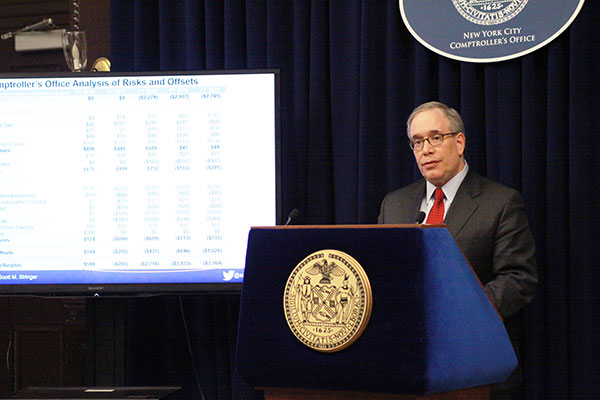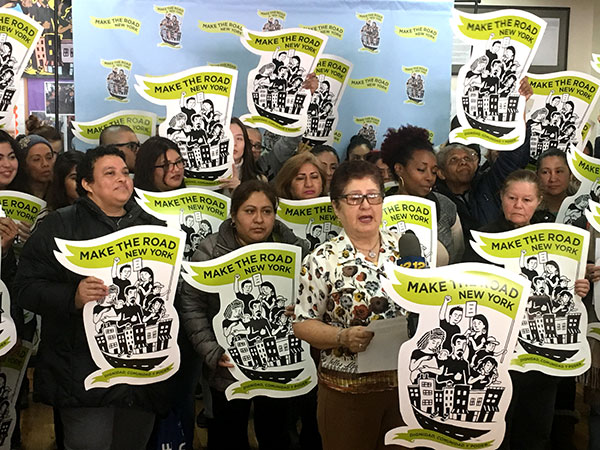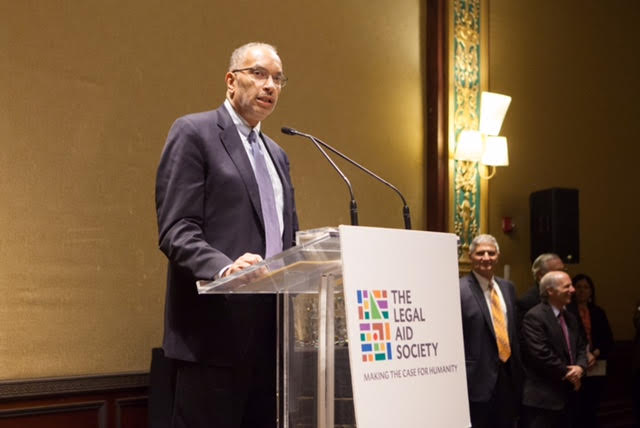A Better Budget for New York

Comptroller Scott Stringer, the author
Discoveries of "Super Earths." Contact lenses with data displays and video cameras. Earpieces that translate different languages in real-time. We are truly in the great age of technology and innovation. Knowledge, access, and new tools are helping us break barriers like never before in human history.
So why, then, does it seem so hard to deliver basic transparency to the city budget? If we're realizing incredible new terrain, why is it so difficult to lay out local government spending in a way that everyday people can understand?
Public budget presentations help us live within our means, control spending, and limit the potential for misuse of taxpayer funds. Every year, the City Council does rigorous review and thorough negotiation, and as a result, in New York we’ve had 35 straight years of balanced city spending plans, enjoy a double-A rating on our municipal bonds, and routinely win awards for our budget.
Openness matters because it induces better outcomes.
But let's say, for instance, an advocate for a particular issue or an ordinary taxpayer wants to know whether $4.9 million in funding has been cut for food pantries and other nutrition services. It would be virtually impossible to know by going online. And if that’s the case for a relatively small line item, it means the $84.7 billion in proposed spending for fiscal year 2018 in the preliminary budget is utterly incomprehensible to the public.
Budgets are about priorities. They’re statements not just on how we spend, but on how we present that spending.
When it comes to clarity and accessibility, we’re failing miserably.
There is, without question, plenty of information about the budget available. The Office of Management and Budget has 18 separate documents on its website about the fiscal 2018 preliminary spending plan, and one of them – the “Departmental Estimates” – is 4,180 pages long.
But just because information is posted online doesn’t mean it’s digestible. Just because something is publicly available doesn’t mean it’s transparent. That’s our problem.
Consider the original, exceptionally basic question: Is there, or is there not, a $4.9 million reduction in funding for food pantries and nutrition services in the fiscal 2018 preliminary budget?
Shockingly, not one of those 18 budget documents provides an answer. That’s because our budget isn’t laid out in terms of the programs and services that agencies deliver. Instead, it’s organized into broad “units of appropriation” and then – in voluminous departmental estimates – converted into budget codes, which are more often used to track funding sources than to describe recognizable programs.
That means unless you’re a seasoned budget expert, you’d have no idea what, if any, spending was proposed for fiscal 2018 for food pantries and nutrition services.
What’s more, it’s logical to wonder what that $4.9 million would buy exactly. How many meals does that fund? How many pounds of food can that purchase? You can’t find that information either in the budget or the Mayor’s Management Report. These simple, public-minded questions are devoid of straightforward government answers.
When it comes to budgetary transparency, even though New York is the financial capital of the world, we’re falling behind. Cities across the country have increasingly made spending information user-friendly and informative. While our budget is huge and complex, it doesn’t mean we can’t make it easier to understand.
A lot easier.
We can start by categorizing the budget in terms of the programs and services that agencies provide, instead of presenting obscure budget codes that aren’t recognizable to anyone other than an agency budget official.
We should also show – and describe, narratively – changes from one year to the next. The public should be able to know exactly why and how proposed spending in the future differs, in programmatic terms, from spending now and prior.
If we’re spending less on a particular program, is it because we figured out how to do it more efficiently? Because demand went down? Or was the program cut as a policy choice? These are simple questions to which we know – and should present – the answers.
Efficiency matters. But by themselves, budget figures don’t tell us much. Taxpayers want to know what we’re buying and whether it’s money well spent. That means adding some basic information to the budget document to show what’s being produced, at what cost, and whether we’re achieving our goals.
Presenting those answers isn’t rocket science – it’s common sense.
We’ve proven we can manage our city’s finances well. But right now, unless you’re a professional budget expert, a seasoned journalist, or an aficionado, our lack of transparency discourages public participation.
We should be giving residents the open government they deserve, because the budget affects every single New Yorker. That means we must take the next step and open the discussion up to everyone, so that communities across the city can help decide the kind of city we want to be down the road.
As for that $4.9 million...it is currently not in next year’s budget. The funds were added this year by the City Council to provide emergency food to 180 pantries and soup kitchens citywide, and to help expand access to healthy foods at farmer’s markets and elsewhere. The Council and the Mayor will decide whether to add the funds again for next year’s budget.
Because, after all, budgets are about priorities.
***
Scott Stringer is New York City Comptroller. On Twitter @scottmstringer.
***
Have an op-ed idea or submission for Gotham Gazette? Email This email address is being protected from spambots. You need JavaScript enabled to view it.
New York’s Immigrant Families Need Action from Albany

(photo: Make the Road NY)
Sixteen years ago, my daughter was about to give birth, and I knew she needed my help to take care of my new grandchild. So I came to the United States. I have now been here for 16 years, and I have six grandchildren. We are Americans through and through.
I've worked hard to educate and support my family. But we’re now in a moment when we're under attack from Donald Trump's administration—it’s the worst political moment that immigrant communities like mine have faced since I arrived in 2001. But we’re here to stay, and we’re not going anywhere.
Since Trump’s election, my community has faced the fear of a newly-elected strongman who has pledged to tear our families apart. We have responded not by hiding in the shadows, but by showing our resilience. We have gone to Know Your Rights workshops. We have spoken with our families and our neighbors to prepare ourselves. And we have taken to the streets to protest.
What we have yet to see, however, is strong action from New York State to show us that our state government has our backs. And that’s why last week I joined other members of Make the Road New York to introduce our Immigrant Opportunity Agenda—a platform for Albany’s leaders to show that they really stand with immigrants.
Our undocumented families are suffering from the president's attacks and attempts to separate us, which cause fear and pain. That’s why our New York platform calls for Governor Cuomo and the State Senate to pass the New York Liberty Act—which has already passed the State Assembly—to keep families together and keep all New Yorkers safe. The Liberty Act limits cooperation between state and local agencies and federal immigration enforcement, and it prevents sharing of information about our immigration status. This bill would help my family feel relief and support from our state government.
Meanwhile, the statewide expansion of another program, the New York Immigrant Family Unity Project, would make sure that all immigrants facing deportation would have access to a lawyer. For families at risk of being torn apart, having a lawyer can be the difference between a mother like me seeing my child again—or being sent off to a country that I no longer know.
The Immigrant Opportunity Agenda also calls for driver’s licenses for all, which is so important for families like mine. Twelve other states have access to licenses for all, regardless of immigration status. Particularly in areas with little public transportation, immigrant New Yorkers often have to drive to get to work or drop their kids off at school. Everyone should have access to licenses, which will help protect our families and make our roads safer.
To make sure that immigrant families enjoy the opportunities we deserve—and that we get our fair share of the billions we pay in New York State taxes—the Immigrant Opportunity Agenda also includes the DREAM Act, to ensure equal access to college for all of our youth, and increased funding for adult education. And it demands that New York step up for workers by cracking down on wage theft, one of the key ways that immigrant workers continue to be exploited.
The governor has said he stands with immigrants. But neither he nor the State Senate—whose Republican leaders have mostly endorsed Trump’s agenda— has yet pushed legislation or significant budget items to protect our community and ensure our access to opportunity.
It’s not too late. The Immigrant Opportunity Agenda shows how New York can ensure that we are all protected from attacks by President Trump and New York politicians who have embraced Trumpism. Now, more than ever, we need Albany leaders to show whose side they're on.
***
Magdalena Brito is a member of Make the Road New York. On Twitter: @maketheroadny.
***
Have an op-ed idea or submission for Gotham Gazette? Email This email address is being protected from spambots. You need JavaScript enabled to view it.
For Local Defenders and Their Clients, This Year Is Different

Seymour W. James Jr., the author
It's budget season at City Hall. Since early March and for the next few weeks, the City Council will hold a gamut of hearings reviewing the financial needs of each city agency for the upcoming fiscal year. Press conferences are held, commissioners are grilled, and community based organizations try to make the case to Council members for more funding to serve their constituents.
The Legal Aid Society testified last Tuesday before the Committee on Courts and Legal Services, and we too urged for increased dollars to handle growing demand for the services we provide.
But this time it's different. It's different because our clients and other low-income New Yorkers are dealing with a growing number of unprecedented external threats like no other time in recent memory. Immigrants, LGBTQ, and black and brown communities have all felt this change in the wind. If New York is truly going to be a sanctuary, truly going to be a place of gender inclusivity and acceptance, and truly going defend the ground we've made reforming the criminal justice system and protecting civil rights, we need a budget that reflects these priorities and reflects these values.
By now, there’s no hiding President Trump’s prejudice against immigrants. His slapdash executive orders and homeland security memorandums - building on the vitriolic diatribes from his campaign – have made this crystal clear. What we’ve seen from the White House over the last 60 days is just the beginning and New York City needs to fortify local organizations working in the trenches to protect immigrant and other vulnerable families.
One way the city can step up is to baseline funding guaranteeing legal representation for those in deportation proceedings – a right unfortunately not provided by the constitution. The New York City Council, under the leadership of Speaker Melissa Mark-Viverito, has increased funding tremendously to support this exact effort through the New York Immigrant Family Unity Project (NYIFUP). The results are staggering, and NYIFUP has kept many local families together. Mayor de Blasio must work with the Council to ensure NYIFUP’s network of direct providers has the tools to fight today, tomorrow, and well into the future.
Another specific concern relating to immigration that needs funding priority is legal protection for unaccompanied minors. Violence is the leading factor forcing unaccompanied children from Central America to the United States. No law or program shields these minors from being sent back to their home countries – almost every child who arrives in the United States is put into deportation proceedings. The City Council’s Unaccompanied Minors and Adults with Children initiatives provide legal representation, but the current funding allocation doesn’t meet the need. Given Trump’s crusade against all undocumented, only a significant enhancement of this initiative will close the service gap for children newly coming before New York immigration court.
Last, but equally important, is Legal Aid’s continued work on Rikers Island and in other correctional facilities through our Prisoners’ Rights Project (PRP). For nearly 40 years, PRP has worked through litigation, advocacy, and monitoring to change policies and practices which have created unjust and abusive treatment of locally incarcerated men and women.
The Council understands this plight and created an initiative to exclusively support PRP's work in the city’s jails, but the conditions in state prisons are also deplorable and raising PRP’s Council allotment to $1 million will broaden our capacity to represent New York City residents imprisoned in the state system.
So in the spirit of Gideon vs Wainwright, a precedent-setting court case that turns 54 this week, and one that guaranteed representation to defendants in criminal court, the city must step up in these tough times. We are mindful of the financial challenges posed by the Trump administration but these programs should be strengthened; low-income New Yorkers need counsel now more than ever.
***
Seymour W. James Jr. is Attorney-In-Chief of The Legal Aid Society. On Twitter @LegalAidNYC.
***
Have an op-ed idea or submission for Gotham Gazette? Email This email address is being protected from spambots. You need JavaScript enabled to view it.




